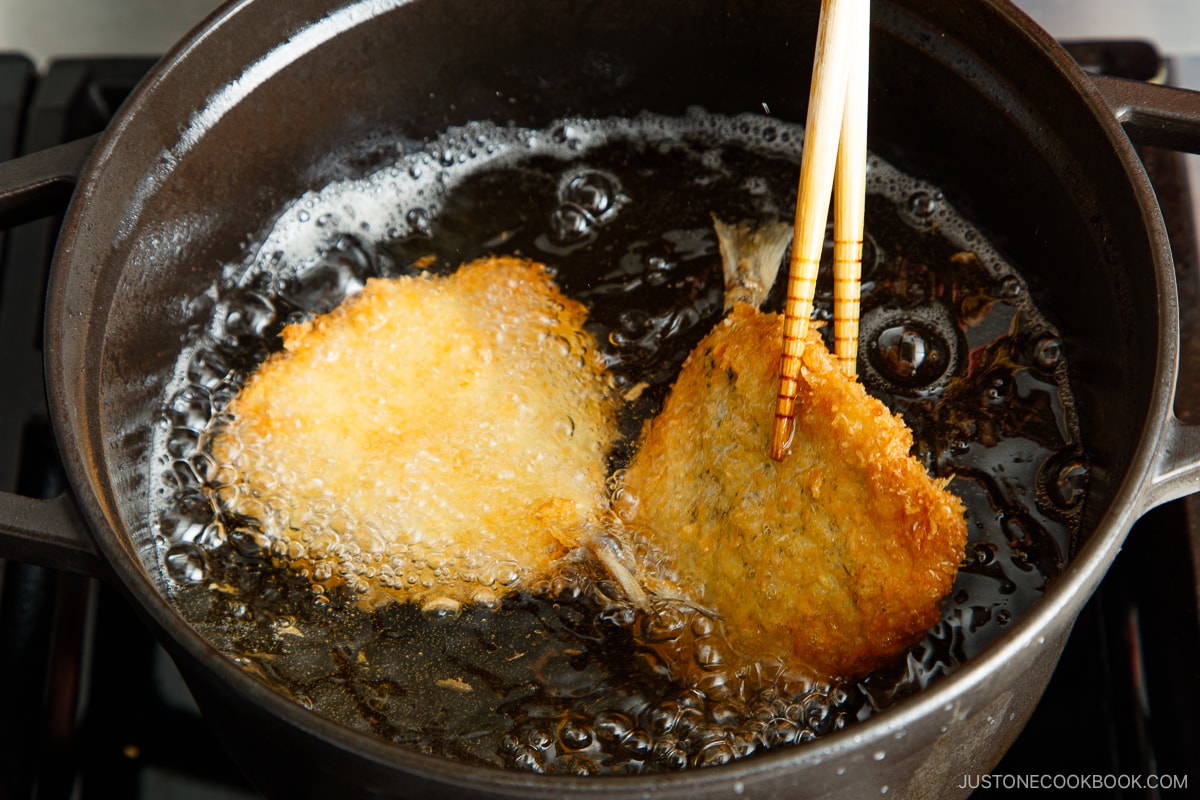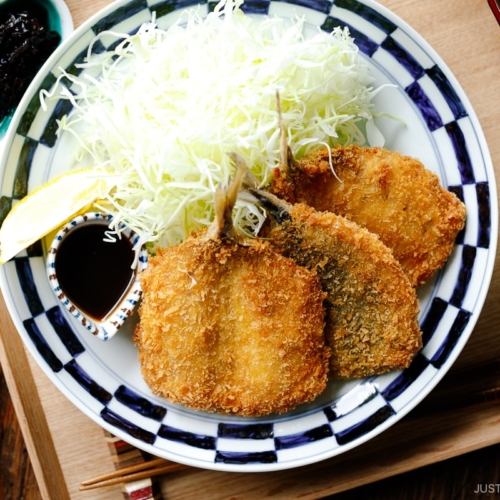Easy Aji Fry is a popular Japanese homestyle dish of crispy, deep-fried horse mackerel. You can buy the fillets already butterflied, then simply bread in panko and fry until golden. Enjoy this tasty bite with tangy Worcestershire sauce or your favorite Japanese sauce.

Fish dishes such as Miso Salmon, Saba Shioyaki, and Miso Cod regularly appear on Japanese dinner tables at home, and today I’m excited to introduce another favorite: Aji Fry (あじのフライ), which literally translates to fried horse mackerel.
Aji fry might not be on everyone’s radar, but it is, in fact, one of Japan’s most popular homestyle dishes. When horse mackerel is in season, I love frying up the fish and enjoying the rich taste. They are crispy on the outside, and juicy and flaky on the inside, making you want to go for bite after bite! It is probably one of my kids’ favorite fish dishes.
Table of Contents

Why You’ll Love This Recipe
- Easy to make yet so delicious!
- A different twist on preparing and eating fish to spice up your meals!
- The crunchy outer layer and juicy, tender meat inside the fish are amazing.
- Packed with protein and vitamins.
- Can be made in batches and stored for the week or as bento lunch boxes.
About Aji Fry in Japan
Fried Horse Mackerel, also known as aji fry (アジフライ), is panko-breaded horse mackerel that is traditionally butterflied and deep-fried until golden brown. It’s the perfect way to enjoy the mackerel’s sweet meat and overall deliciousness.
Horse mackerel can be found throughout the year but is at its peak during the summer. It is light and easy to eat, with just the right amount of fat, making it perfect for sashimi and deep-frying.

Aji fry can be found anywhere from izakayas to teishoku menus (set meals). It’s also a staple in home cooking, making it an easy and delicious way for children to enjoy fish. Leftovers can be packed into bento lunch boxes. Typically served alongside steamed rice, shredded cabbage, and Worcestershire-based sauce, Aji Fry makes for a delicious and nutritious meal!
Did you know the Japanese word for horse mackerel, Aji (鯵), also means “taste” (味)? This fish’s name likely derives from the “taste” because of its tastiness!

Ingredients for Fried Horse Mackerel
Most ingredients to make fried horse mackerel can easily be found in your local supermarket.
- Horse mackerel or Aji (鯵)
- Salt – I use kosher salt (here’s why)
- Flour
- Eggs
- Panko (Japanese breadcrumbs)
- Neutral oil for deep-frying
- To serve: Tonkatsu sauce, Worcestershire sauce, or tartar sauce and lemon wedges
I like to drizzle Worcestershire sauce on my Aji Fry as the tangy sauce cuts the greasiness. You can also use tonkatsu sauce, which has a milder flavor. If you can’t find tonkatsu sauce, then you can try out my Homemade Tonkatsu Sauce recipe!
How to Make the Best Aji Fry
Please scroll down to the recipe card for the exact measurements and detailed recipe instructions.
Jump to Recipe- Butterfly the horse mackerel (see the next section below) and season it with salt.
- Coat the fish with flour, egg, then panko.
- Deep-fry at 340ºF (170ºC) over medium heat until golden brown and cooked.

Substitution Tips and Variations

- You can use fillets if you can’t get your hands on butterflied horse mackerel. While you don’t get the traditional shape of aji fry, you’ll still be able to enjoy its delicious taste, textures, and all the nutrients.
- Horse mackerel may be difficult to find, so look for local mackerel in your area. If unavailable, herring or sardines are suitable replacements.
- Aji fry also pairs well with Homemade Tartar Sauce, simply made with eggs, mayonnaise, and other ingredients!
How to Butterfly Horse Mackerel

Butterflying horse mackerel can be challenging if you are not used to handling fish. If possible, try to have your horse mackerel butterflied by your local fishmonger as it will save you a lot of stress and work!
- Scrape off all the scales from the horse mackerel.
- Cut off the head by diagonal cuts from the pectoral (side) fin to the pelvic (bottom) fin.
- Cut the belly open and scrape out the internal organs using the back of your knife.
- Wash the inside of the belly under running cold water.
- From the belly to the tail, use gentle and long slices to cut all the way to the backbone but not all the way through. Your knife edge should be as close to the bones as possible to avoid cutting any flesh.
- Flip over and repeat.
- Using a pair of scissors, cut off the backbone.
- Spread the mackerel out, using the tip of your knife, and slice off the ribs that are against the flesh near the belly.
This cutting method from the belly side is known as harabiraki (腹開き). There is also a reverse method, where you cut from the dorsal side, known as sebiraki (背開き).
Unfortunately, I can’t get the whole horse mackerel in my area to demonstrate this process. If you need the visuals, watch this video tutorial.

Recipe Tips and Techniques
- For fresh horse mackerel, look for clear eyes, bright red gills, shiny scales, and no scratches on the fins or body.
- Sprinkle salt on the horse mackerel while preparing all the ingredients. Salt helps remove some of the fishy odor, extracts moisture, and enhances the fish’s seasoning.
- Hold it by its tail when breading the fish so your hands don’t get too messy!
- Be sure to press the panko onto the horse mackerel so it covers and sticks to the flesh and skin completely.
- After deep frying, the residual heat will continue to cook, so remove it from the oil slightly earlier than you think to prevent overcooking.
How to Store
- To Store. Refrigerate leftover aji fry in an airtight container for up to 3 days.
- To Reheat. For the best results, reheat leftover aji fry at 350°F (180°C) in the oven.
- To Freeze. Freeze the aji fry in a single layer on a baking sheet until solid. Transfer to an airtight container or resealable freezer bag and freeze for up to 3 months. Reheat directly from frozen.
What to Serve with Aji Fry


Prepare the following dishes for a complete Japanese teishoku meal!
- Rice – How to Cook Rice on the Stove
- Soup – Miso Soup with Enoki Mushrooms and Ground Sesame
- Salad – Traditionally, thinly sliced cabbage is served for a refreshing bite, but you can also serve Japanese Potato Salad or Asian Cabbage Salad.
- Sides – To help cleanse your palate and cut through all the different tastes, Japanese pickles (tsukemono) are often served. This Daikon Amazuzuke might go well.

Wish to learn more about Japanese cooking? Sign up for our free newsletter to receive cooking tips & recipe updates! And stay in touch with me on Facebook, Pinterest, YouTube, and Instagram.

Fried Horse Mackerel (Aji Fry)
Ingredients
- 6 fillets Atlantic horse mackerel (butterflied; substitute with Pacific Jack mackerel; I bought the frozen package from Nijiya Market, as shown in the blog post)
- ¼ tsp Diamond Crystal kosher salt
- ¼ cup all-purpose flour (plain flour)
- 1 large egg (50 g each w/o shell)
- 1 cup panko (Japanese breadcrumbs)
- 3 cups neutral oil (or enough for 1 inch, 2.5 cm of oil in the pot; for deep-frying)
Instructions
- Gather all the ingredients.

- Add 3 cups neutral oil to a heavy-bottomed pot (I use a 2.75-quart Staub Cast Iron Round Cocotte). You‘ll need at least 1 inch (2.5 cm) of oil. Bring it to 350°F (180°C) over medium heat. Meanwhile, sprinkle 6 fillets Atlantic horse mackerel on both sides with ¼ tsp Diamond Crystal kosher salt. Set it aside while you prepare the breading ingredients.

To Bread the Fillets
- Prepare three separate deep dishes with ¼ cup all-purpose flour (plain flour), 1 large egg (50 g each w/o shell), and 1 cup panko (Japanese breadcrumbs). Whisk the egg until beaten. Now, bread the fish. First, hold the fish by the tail and dredge the fillet in flour (do not bread the tail). Dust off the excess.

- Next, dip the fillet in the beaten egg and coat well.

- Finally, dredge the fillet in the panko, gently pressing the breadcrumbs onto the fish. Gently shake off any excess panko, then place it on a tray or plate. Continue breading the other fillets.

To Deep-Fry
- Meanwhile, check that the oil temperature is 350°F (180°C) with an instant-read thermometer. Or, stick a wooden chopstick in the oil; you‘ll know it‘s hot enough if you see tiny bubbles appear around the tip. You could also drop a piece of panko into the oil; if it sinks halfway and immediately pops back up to the surface, then the oil is ready. To cook, add two fillets to the oil and fry for 2 minutes, flipping halfway through. Tip: Fry in batches and do not crowd the pot. Your ingredients should take up no more than half of the oil surface area at any one time. If you add too much food at once, the oil temperature will drop and the fish will absorb too much oil. Maintain the correct oil temperature throughout cooking. For more helpful tips, see my post How to Deep-Fry Food.

- After 1 minute, flip the fillets and fry for another minute or until both sides are golden brown. If your oil gets too hot, lower the stove’s heat or/and add the next batch to cool down the oil.

- Remove the fillets from the oil, holding them vertically over the pot for a few seconds to drain the excess. Then, transfer to a wire rack or tray lined with a paper towel to drain. Continue to fry the remaining fillets. In between batches, collect the crumbs from the oil with a fine-mesh skimmer. If left, these crumbs will burn and make the oil darker, so make sure to keep the oil clean throughout deep-frying. When ready to serve, transfer the Aji Fry to individual plates.

To Serve
- In Japan, we usually serve deep-fried food with a side of finely shredded cabbage. I love to use a cabbage slicer because it saves time and energy! Aji Fry is delicious served with a side of Worcestershire sauce, Homemade Tonkatsu Sauce (or any kind of Japanese sosu (sauce) you‘d like), and/or Homemade Tartar Sauce. Enjoy!

To Store
- Store the Aji Fry in an airtight container for up to 3 days in the refrigerator. Reheat in the oven at 350ºF (180ºC). To freeze, place the Aji Fry in a single layer on a baking sheet until solid. Transfer to an airtight container or resealable freezer bag and freeze for up to 3 months. Reheat directly from frozen.

















